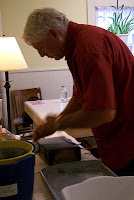 I've been working on a custom order for the past week. The order is for a bronze pendant which came out beautifully and only took 1 day to create. But I've spent the last 5 days trying to find the proper firing schedule for it.
I've been working on a custom order for the past week. The order is for a bronze pendant which came out beautifully and only took 1 day to create. But I've spent the last 5 days trying to find the proper firing schedule for it.I made a real rookie error with this order--I created the piece from a product I've never used before. I've tried and successfully created jewelry from a couple of different bronze clay products. These were powders that you have to add water to. Their firing schedules are pretty easy and one is even comparatively short. But I didn't like the final color of one and the other shrank way too much. But an instructor suggested I try Bronzclay. It comes already in clay form. As I was almost out of bronze clay, I ordered 200 grams.
My friend was right. It's not grainy like one of the powdered products, stays moist longer, and reconstitutes easily. So right out of the package, after working it a little, I created my custom order.
I also created a couple of test strips and fired them together according to instructions in the package. The thinner (2mm) strip came out fully sintered but with pinholes. I'm no expert but I think that means it was over-fired. The thicker textured strip (3mm) snapped in half when I tried to bend it and the black bonding material was exposed. What does it mean when the binder burns off on 1 piece but not the other?
I adjusted the schedule a bit and tried again to fire a pair of earrings. This time the binder didn't burn out on either piece.
What did we do before we had Google and all the information people throw up on the Web? In my search for sintering problems and firing schedules for Bronzclay I found that I was not alone with my problem. There were no less than 6 different firing schedules put up by metal clay experts that work for them. Some used a single firing method buried in carbon, some used a 2 step process in carbon, some fired initially on an open shelf then used a 2 step buried-in-carbon schedule. Others followed the open shelf with a 1 step schedule. Some schedules were for specific style kilns. All are very long schedules--easily 9 hours.

After 4 days of trials, the open shelf initial firing to burn out the binder did the trick but the follow up firing caused my next pair of earrings to become brittle and break. But using a 2-step ramp up and dropping the final temperature some in the second firing seemed to do the trick, at least for the small flower pendant I made.
How you dry the clay may contribute to the problem. It shouldn't be put on a coffee warmer but instead needs to air dry. I found articles suggesting freezing the clay to dry it.
I'm not sure that makes any difference but before I put my custom pendant into the kiln I decided to try a few more pieces to see if I get the same result. These were also left in the freezer for awhile before firing though I'm not sure why I did that. They had air dried for a couple days already.
After the successful firing of a few more pieces....
I fired the custom piece. Voila!!
This bronze product polishes up nicely too.
For those who might be interested, and to add yet another firing schedule to the internet, I achieved this success by placing pieces on an open shelf and a slow ramp of 250°F to 560° F , hold 30 min and cool down. Then burying pieces in coconut carbon, full ramp to 800°F or 900° F, no hold and ramping at 250°
to 1468°F, hold for 2 hours and cool. Yes, it's a full day in the kiln.








































.jpg)


.jpg)